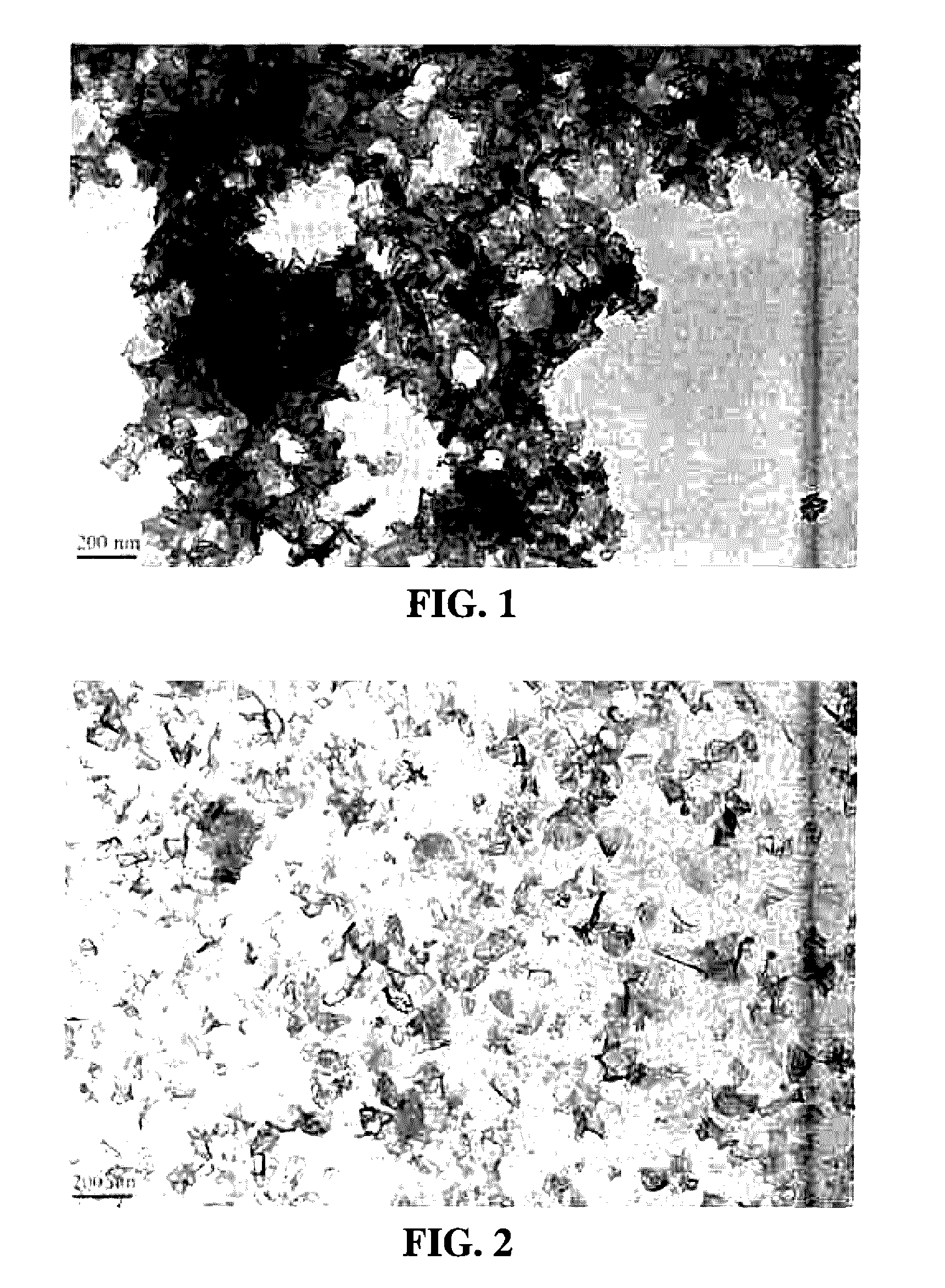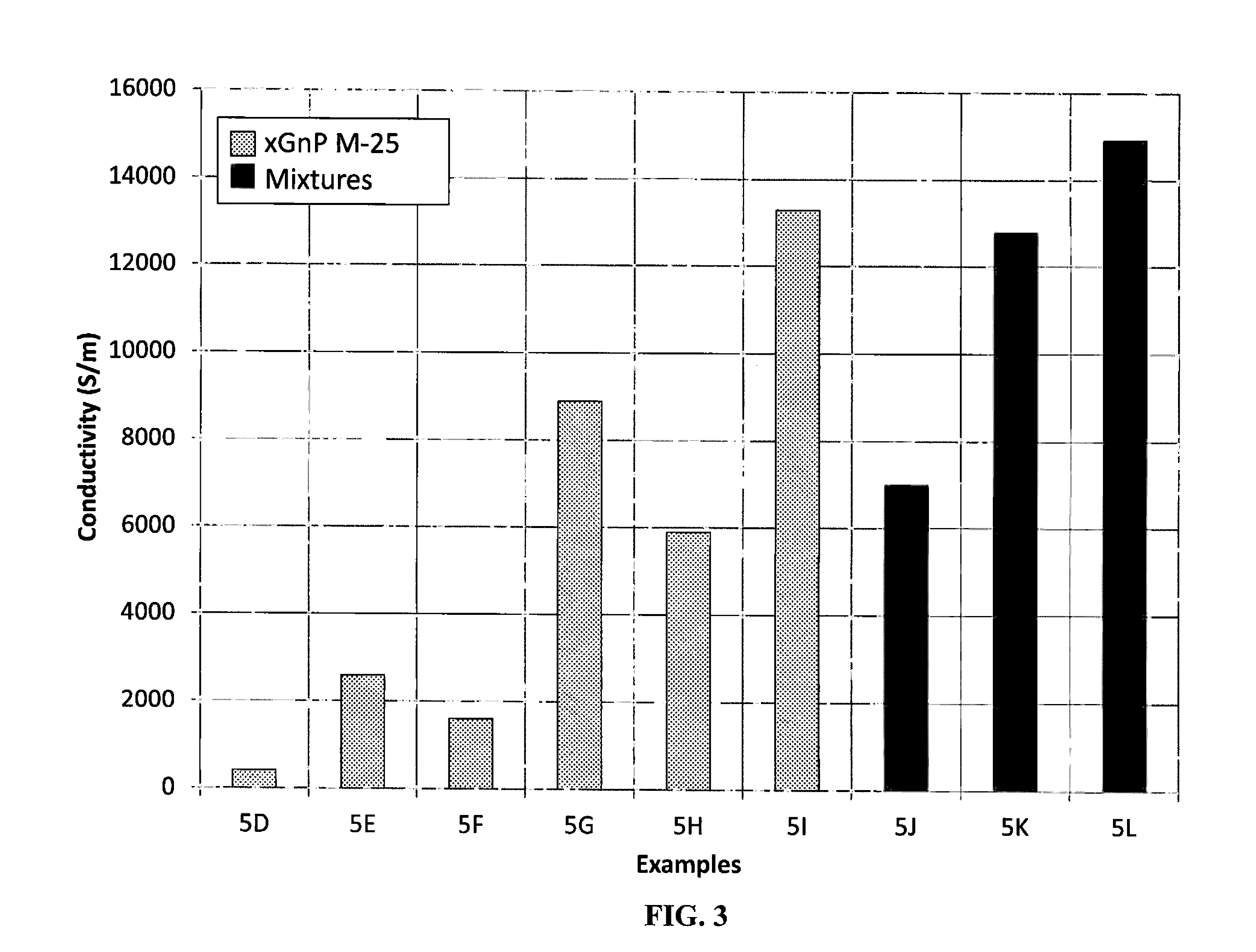Graphenic carbon particle dispersions and methods of making same
a technology dispersions, which is applied in the direction of carbon-silicon compound conductors, electrically conductive paints, coatings, etc., can solve the problems of difficult dispersibility of graphenic carbon particles in various media
- Summary
- Abstract
- Description
- Claims
- Application Information
AI Technical Summary
Benefits of technology
Problems solved by technology
Method used
Image
Examples
example 1
[0058]Compositions A, B, C, and D listed in Table 1 were dispersed by adding 70 g of each into 8 oz. glass jars with 220 g of SEPR Ermil 1.0-1.25 mm milling media. The samples in the jars were shaken for 4 hours using a Lau disperser (Model DAS 200, Lau, GmbH). The milling media was then filtered off from the dispersions. Compositions E, F and G listed in Table 1 were dispersed at 12.5 weight percent based on total solids by sonicating for 2 hours in a bath sonicator in (E) n-methyl-2-pyrrolidone, (F) methyl ether propylene glycol (Dowanol PM Acetate, Dow Chemical), and (G) n, n-dimethylacetimide.
[0059]
TABLE 1Solvent-Borne DispersionsSamples (Weight %)IngredientsABCDEFGAcrylic grind vehicle34.3234.32Polyester resin solution15.4315.43Polyethylene cut0.480.48n-butyl acetate36.7036.7048.7262.21Diisobutyl ketone7.537.53n-methly-2-pyrrolidone87.5Methyl ether propylene glycol 87.5n,n-dimethylacetimide87.5Solvent-borne block42.7331.49copolymer dispersant1xGnP C-30025.568.55Thermally produc...
example 2
[0060]The dispersed formulations from Example 1 (Samples 1A, 1B, 1C, 1D, 1E, 1F and 1G) were added to a commercial solvent-borne black basecoat available from PPG Industries, Inc., at a level such that each basecoat formulation contained 2.36% graphenic carbon particles on a total solids basis, resulting in Samples 2A, 2B, 2C, 2D, 2E, 2F and 2G, respectively. In each paint formulation, the graphenic carbon replaced the same weight of black pigment that is normally contained in this solvent-borne black basecoat. Samples 2E, 2F and 2G were gritty, showing the poor dispersion resulting from sonicating the graphenic carbon particles in solvents.
example 3
[0061]Samples 2A, 2B, 2C and 2D from Example 2 were reduced with n-butyl acetate to spray viscosity, and then sprayed onto e-coated 4×12 inch steel panels. These panels received a standard ambient flash and were then clear coated with a commercial carbamate clear coat available from PPG Industries, Inc. and cured in an oven to produce Samples 3A, 3B, 3C and 3D.
[0062]To quantify the goodness of dispersion of the graphenic carbon particles in Samples 3A, 3B, 3C and 3D, the color of each panel was measured using a BYKmac multi-angle spectrophotometer (BYK-Gardner) and the black jetness was calculated using the 110° angle color data. Jetness was calculated using the equation Jetness=[log10(Xn / X)+ log10(Yn / Y)−log10(Zn / Z)] (Equation 12 from K. Lippok-Lohmer, “Praxisnahe Scharzmessungen”, Farbe+Lack, 92 (1986) 1024-1029.) If the graphenic carbon particles are well dispersed in the paint film, then the resulting light scattering will be reduced and this results in a larger black jetness val...
PUM
| Property | Measurement | Unit |
|---|---|---|
| electrical conductivity | aaaaa | aaaaa |
| electrical conductivity | aaaaa | aaaaa |
| electrical conductivity | aaaaa | aaaaa |
Abstract
Description
Claims
Application Information
 Login to View More
Login to View More - R&D
- Intellectual Property
- Life Sciences
- Materials
- Tech Scout
- Unparalleled Data Quality
- Higher Quality Content
- 60% Fewer Hallucinations
Browse by: Latest US Patents, China's latest patents, Technical Efficacy Thesaurus, Application Domain, Technology Topic, Popular Technical Reports.
© 2025 PatSnap. All rights reserved.Legal|Privacy policy|Modern Slavery Act Transparency Statement|Sitemap|About US| Contact US: help@patsnap.com



